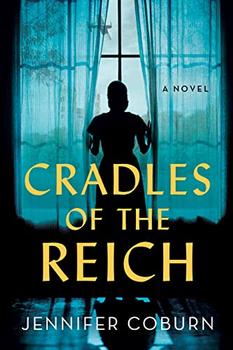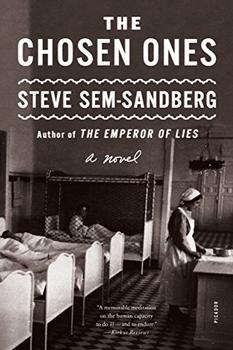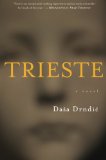Summary | Excerpt | Reading Guide | Discuss | Reviews | Beyond the book | Read-Alikes | Genres & Themes | Author Bio

A Novel
by Jennifer CoburnJennifer Coburn's first historical novel, Cradles of the Reich, is a well-researched chronicle of Nazi Germany's attempt to breed "racially pure" babies to counteract the country's falling birth rate. The brainchild of Heinrich Himmler, the Lebensborn ("Fount of Life") program established maternity homes for "worthy" women in need of assistance in childbirth—generally unwed mothers, wives or widows of German soldiers who met the physical standards the Nazis prized (i.e., were young, blond, blue-eyed and physically fit). It quickly devolved into a system whereby women were treated no better than breeding stock. The babies of unwed mothers were given to high-ranking officers' wives to raise, "mothers-in-training" were kept onsite to service (and hopefully be impregnated by) high-ranking officers, and children of Aryan-looking couples in conquered countries like Poland were stolen from their parents and given to patriotic Germans to raise.
Coburn's novel explores this lesser-known aspect of Germany's history through the imagined stories of three women affected by the Lebensborn program. Gundi Schiller is the perfect physical specimen, the ideal Aryan female. When she becomes pregnant, her mother applies to have her sent to Heim Hochland, the first Lebensborn home to be opened. Gundi's mother, however, is unaware that the baby's father is Jewish and that Gundi's sympathies don't lie with the Reich. Hilde Kramer is temperamentally Gundi's opposite, conniving and eager to be seen as a person of consequence. A true believer in Nazi propaganda, she becomes pregnant by a high-ranking married officer and is likewise sent to Heim Hochland to give birth. Finally, Irma Benz, a nurse who'd served in WWI, agrees to join the endeavor to help deliver babies and assist with adoptions at the facility. Each chapter of the narrative alternates among their three points of view.
Cradles of the Reich is powerful historical fiction. Coburn is remarkably skilled at bringing this mostly forgotten Nazi-era program to the page with both depth and nuance. Both her research and her attention to period details are impressive. Although most have likely read at least something about the innumerable human rights abuses wreaked by Germany's fascist government, the author reminds us anew, in a truly visceral way, of the unfathomable harm a group of powerful leaders can inflict on a segment of the population if left unchecked. One disturbing scene follows another, until all the unsettling aspects of the Lebensborn program gradually come to light, through images readers won't soon forget.
The novel is a quick, engrossing read, but it's not quite at five-star level. Although Gundi's character is well-drawn and Irma especially exhibits a great deal of growth over the course of the story, other characters could have used a little more depth; Hilde in particular seems a bit one-dimensional. In order to convey the horrors of the Lebensborn program through her characters' eyes, Coburn largely has them function as observers; as a result they sometimes seem a little disconnected from the action. Readers, who will undoubtedly become invested in these women's lives, may long for an epilogue, as each of their storylines ends rather abruptly and questions remain about what each character's future might hold. In spite of these points, the novel remains a worthwhile read; its fascinating historical underpinnings more than compensate for these minor flaws.
Cradles of the Reich is a solid choice for book clubs, whose members can explore questions about eugenics and the influence of political power on human behavior. Although the story revolves around sexual situations, the scenes aren't overly explicit, making it a good choice for mature teens as well. Overall, Cradles of the Reich will appeal to fans of historical fiction, particularly those unfamiliar with the Lebensborn program or those who have an interest in the lesser-known aspects of WWII.
![]() This review was originally published in The BookBrowse Review in November 2022, and has been updated for the
August 2023 edition.
Click here to go to this issue.
This review was originally published in The BookBrowse Review in November 2022, and has been updated for the
August 2023 edition.
Click here to go to this issue.

If you liked Cradles of the Reich, try these:

by Steve Sem-Sandberg
Published 2017
Passionately serious, meticulously researched, and deeply profound, this extraordinary and dramatic novel bears witness to oppression and injustice, and offers invaluable and necessary insight into an intolerable chapter in Austria's past.

by Dasa Drndic
Published 2015
"A masterpiece" (A.N. Wilson), this many-layered novel of WWII combines fiction with a Sebaldian collage of facts to explore the fate of Italian Jews under Nazi occupation, through the intimate story of a mother's search for her son
Poetry is like fish: if it's fresh, it's good; if it's stale, it's bad; and if you're not certain, try it on the ...
Click Here to find out who said this, as well as discovering other famous literary quotes!
Your guide toexceptional books
BookBrowse seeks out and recommends the best in contemporary fiction and nonfiction—books that not only engage and entertain but also deepen our understanding of ourselves and the world around us.